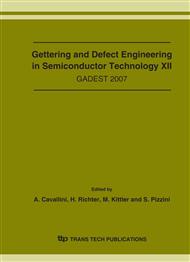p.283
p.289
p.293
p.303
p.309
p.315
p.321
p.327
p.333
A Comparative Analysis of Structural Defect Formation in Si+ Implanted and then Plasma Hydrogenated and in H+ Implanted Crystalline Silicon
Abstract:
Transmission electron microscopy (TEM) and scanning electron microscopy (SEM) have been used to compare hydrogen defects formed in p doped [001] oriented Cz silicon samples which are H+ plasma treated , H+ implanted or Si+ implanted + H+ plasma treated. Samples were studied as processed and after annealing at 250°C, 450°C and 600°C. It is found that 1 hour H+ plasma treatment at 250°C produces a low density of large defects (~100 nm) in prefered {111} plans close to the surface. H+ implantation at a dose of 3x1016 cm-2 produces high density of small (~ 20 nm) mostly {100} platelets that after 1 hour annealing at 450°C result in microcrack formation. Lower H+ implantation doses form very few microcracks at this temperature. Silicon implantation with a dose of 1015 cm2 followed by 1 hour H+ plasma treatment at 250°C and 1 hour annealing at 450°C produces similar microstructure and microcracks as the 3x1016 cm2 H+ implantation dose.
Info:
Periodical:
Pages:
309-314
Citation:
Online since:
October 2007
Keywords:
Price:
Сopyright:
© 2008 Trans Tech Publications Ltd. All Rights Reserved
Share:
Citation:


